Low-Carbon Economic Dispatch Based on a CCPP-P2G Virtual Power Plant Considering Carbon Trading and Green Certificates
Abstract
:1. Introduction
2. Operating System of VPP
2.1. Operating Structure of VPP
2.2. CCPP-P2G Operating System
2.2.1. Operating Structure of CCPP-P2G
2.2.2. Operating Cost Model of CCPP-P2G
- Generation cost of CCPP
- 2.
- The cost of carbon tax
- 3.
- Carbon storage cost of CCPP
- 4.
- The operating cost of P2G
2.3. Renewable Energy Operating System
2.3.1. Renewable Energy Consumption Mechanism
2.3.2. Cost Model of Renewable Energy System
- Power generation cost of WP and PV units
- 2.
- Penalty cost of renewable energy abandonment
2.4. Two-Stage Model of PBDR
2.4.1. Demand Price Elasticity Model
2.4.2. Load Allocation Model
2.5. Carbon Trading Market Transaction Model
2.6. Green Certificate Market Transaction Model
3. Dispatching Optimization Model of VPP
3.1. Objective Function
3.2. Constraints
- Power balance constraint of the VPP is:
- 2.
- Reserve capacity constraint of the VPP [7] is:
- 3.
- Constraints on CCPP-P2G are:
- 4.
- CO2 used constraints on P2G
- 5.
- Constraints on carbon emission allowances and carbon transaction costs are shown in Section 2.5.
- 6.
- In conjunction with the renewable energy consumption guarantee mechanism, the system needs to meet the weight constraint of renewable energy consumption, as shown in the Section 2.6.
3.3. Model Solving
4. Case Study
4.1. Basic Data
4.2. Scenario Setting
4.3. Results of Scenarios
4.3.1. Scenario 1
4.3.2. Scenario 2
4.3.3. Scenario 3
4.3.4. Scenario 4
4.4. Analysis of Results
4.4.1. CCPP-P2G Operation Effect Analysis
4.4.2. PBDR Implementation Effect Analysis
4.4.3. Carbon Trading Benefit Analysis
4.4.4. Green Certificate Benefit Analysis
4.4.5. CO2 Emission Reduction Benefit Analysis
4.4.6. Unit Power Generation Cost Analysis
4.4.7. WP and PV Output Fluctuation Analysis
5. Conclusions
- (1)
- On the one hand, CCPP-P2G coupling can realize the use of carbon, reduce the emission of carbon dioxide in the atmosphere and improve the economy of the system; on the other hand, P2G realizes the energy conversion between electricity and natural gas, which can reduce the system’s cost. The cost of abandonment of wind will further improve the capacity of wind and solar absorption, which is conducive to optimizing resource allocation, improving energy utilization efficiency, economic efficiency of system operation and flexibility of dispatching. The results show that the optimized model reduces the net cost of the virtual power plant by about 27.94%, greatly improves the profitability and reduces carbon emissions by nearly 50%, which promotes the realization of low-carbon systems.
- (2)
- PBDR can guide users to respond to system dispatch through the implementation of peak-valley time-of-use electricity prices, which reduces the power load during the tight period of load supply and demand, smooths the load curve and improves the system’s ability to adjust to changes in renewable energy output. While optimizing the energy structure and reducing carbon emissions, it also reduces the net cost of the system and improves the economics of the system.
- (3)
- Under the policy environment of carbon quotas and the renewable consumption guarantee mechanism, the use of a carbon trading market and green certificate trading market can meet the requirements of the VPP for carbon emissions and renewable consumption. Moreover, the operating cost of the VPP can be greatly compensated by trading abundant carbon emission credits and green certificates. Therefore, in the process of increasing the proportion of renewable energy power generation and achieving the goal of “dual carbon”, the use of carbon trading and the green certificate market can effectively coordinate the balance of environmental and economic benefits.
Author Contributions
Funding
Institutional Review Board Statement
Informed Consent Statement
Data Availability Statement
Acknowledgments
Conflicts of Interest
References
- Qiu, W.; Wang, M.; Lin, Z.; Yang, L.; Wang, L.; Sun, J. Comprehensive evaluation of shared energy storage towards new energy accommodation scenario under targets of carbon emission peak and carbon neutrality. Electr. Power Autom. Equipment. 2021, 41, 1–12. [Google Scholar]
- Zhang, D.; Wang, J.; Lin, Y.; Si, Y. Present situation and future prospect of renewable energy in China. Renew. Sustain. Energy Rev. 2017, 76, 865–871. [Google Scholar] [CrossRef]
- Jinping, X. Statement by H.E. Xi Jinping President of the People’s Republic of China at the General Debate of the 75th Session of the United Nations General Assembly. Peace 2020, 3, 5–7. [Google Scholar]
- China Renewable Energy Development Report. China Renew. Energy Dev. Rep. 2021, 34, 7.
- Lin, Y.; Miao, S.; Yang, W.; Yin, B.; Tu, Q.; Ye, C. Day-ahead optimal scheduling strategy of virtual power plant for environment with multiple uncertainties. Electr. Power Autom. Equip. 2021, 1–8. [Google Scholar]
- Xia, Y.; Liu, J. Review of virtual power plant based on distributed generation. Electr. Power Autom. Equip. 2016, 36, 100–106. [Google Scholar]
- Sun, H.; Liu, Y.; Peng, C.; Meng, J. Optimization scheduling of virtual power plant with carbon capture and waste incineration considering power-to-gas coordination. Power Syst. Technol. 2021, 45, 3534–3545. [Google Scholar]
- Xu, F.; Zhou, R.; Cao, J.; Chao, D.; Qian, J.; Wu, X. Coordinated optimal dispatching of power-heat-gas for virtual power plant participating in multiple markets. Proc. CSU-EPSA 2019, 31, 35–42. [Google Scholar]
- Schiebahn, S.; Grube, T.; Robinius, M.; Tietze, V.; Kumar, B.; Stolten, D. Power to gas: Technological overview, systems analysis and economic assessment for a case study in Germany. Int. J. Hydrogen Energy 2015, 40, 4285–4294. [Google Scholar] [CrossRef]
- Götz, M.; Lefebvre, J.; Mörs, F.; Koch, A.M.; Graf, F.; Bajohr, S.; Kolb, T. Renewable power-to-gas: A technological and economic review. Renew. Energy 2016, 85, 1371–1390. [Google Scholar] [CrossRef] [Green Version]
- Yang, C.; Shi, Y.; Wuzhi, Z. Optimal thermoelectric dispatching of regional integrated energy system with power-to-gas. Power Syst. Technol. 2020, 44, 4254–4264. [Google Scholar]
- Zhou, X.; Zeng, R.; Gao, F.; Qu, L. Development status and prospects of the Energy Internet} {Development status and prospects of the Energy Internet. Sci. Sin. Inf. 2017, 47, 149. [Google Scholar]
- Sun, H.; Meng, J.; Peng, C. Coordinated Optimization Scheduling of Multi-region Virtual Power Plant with Wind-power/Photovoltaic/Hydropower/Carbon-capture Units. Power Syst. Technol. 2019, 43, 4040–4051. [Google Scholar]
- Lu, S.; Wu, Y.; Lou, S.; Yin, X. A Model for Optimizing Spinning Reserve Requirement of Power System Under Low-Carbon Economy. IEEE Trans. Sustain. Energy 2014, 5, 1048–1055. [Google Scholar] [CrossRef]
- Zhou, R.; Xiao, J.; Tang, X. Coordinated optimization of new energy consumption by P2G and carbon utilization in carbon capture power plant. Electr. Power Autom. Equip. 2018, 38, 61–67. [Google Scholar]
- Chen, B.; Lin, K.; Zhang, Y. Optimal dispatching of integrated electricity and natural gas energy systems considering the coordination of carbon capture system and power-to-gas. South. Power Syst. Technol. 2019, 13, 9–17. [Google Scholar]
- Sheng, S.; Wu, H.; Gu, Q.; Li, P.; Chen, H. Low-carbon economic operation of integrated electricity and natural gas system with carbon capture devices. Electr. Meas. Instrum. 2021, 58, 82–90. [Google Scholar]
- Müller, T.; Möst, D. Demand Response Potential: Available when Needed? Energy Policy 2018, 115, 181–198. [Google Scholar] [CrossRef]
- Wang, B.; Liu, X.; Li, Y. Day-ahead generation scheduling and operation simulation considering demand response in large-capacity wind power integrated systems. Proc. CSEE 2013, 33, 35–44. [Google Scholar]
- Newsham, G.R.; Bowker, B.G. The effect of utility time-varying pricing and load control strategies on residential summer peak electricity use: A review. Energy Policy 2010, 38, 3289–3296. [Google Scholar] [CrossRef] [Green Version]
- Che, Q.; Lou, S.; Wu, Y.; Zhang, X.; Wang, X. Optimized dispatching of wind power systems considering demand response and thermal power depth peak regulation. Autom. Electr. Power Syst. 2019, 43, 34–41. [Google Scholar]
- Luo, C.; Li, Y.; Xu, H.; Li, L.; Hou, T.; Miao, S. Influence of demand response uncertainty on day ahead optimization dispatching. Autom. Electr. Power Syst. 2017, 41, 22–29. [Google Scholar]
- National Energy Administration. Notice on Establishing and Improving the Guarantee Mechanism of Renewable Energy Consumption; National Energy Administration: Hong Kong, China, 2019.
- Chen, X.; Yuan, M.; Wang, S.; Mu, J.; Peng, H.; Wang, Y. Optimal Scheduling of Integrated Energy System Considering Impact of Carbon Trading on Wind Power Consumption. J. Chongqing Univ. Technol. (Nat. Sci.) 2021, 1–9. [Google Scholar]
- Chen, L.; Peng, D.; Zhang, X.; Tan, Q.; Yu, S.; Tan, Z. Scheduling Optimization Model of Wind Farm Integrated System with Demand Respond and Carbon Emission Trading. J. North China Electr. Power Univ. 2016, 43, 104–110. [Google Scholar]
- Liang, J.; Zuo, Y.; Zhang, Y.; Zhao, X. Energy-saving and Economic Dispatch of Power System Containing Wind Power Integration Under Renewable Portfolio Standard. Power Syst. Technol. 2019, 43, 2528–2534. [Google Scholar]
- Xue, Y.; Zhao, S.; Zhang, X.; Chen, J.; Liu, S. Optimized dispatch of wind power system considering green card-carbon mechanism. J. Tai Yuan Univ. Technol. 2018, 49, 785–792. [Google Scholar]
- Xu, Y.; Liu, S. Source-demand interactive optimal scheduling strategy considering carbon trading and green certificate. Power Demand Side Manag. 2021, 23, 35–39. [Google Scholar]
- Tian, F.; Jia, Y.; Ren, H. ‘Source-load’ low-carbon economic dispatch of integrated energy system considering carbon capture system. Power Syst. Technol. 2020, 44, 3346–3355. [Google Scholar]
- De, G.; Tan, Z.; Li, M. Bidding Strategy of Wind-storage Power Plant Participation in Electricity Spot Market Considering Uncertainty. Power Syst. Technol. 2019, 43, 2799–2807. [Google Scholar]
- Zhang, J.; Fan, W.; Tan, Z. Multi-objective optimization model of gas-electricity interconnected virtual power plant considering demand response. Electr. Power Constr. 2020, 41, 1–10. [Google Scholar]
- Tan, Q. Research on Multi-Energy Complementary Scheduling Optimization and Benefit Evaluation Model in Park. Bachelor’s Thesis, North China Electric Power University, Beijing, China, 2019. [Google Scholar]
- Mansour, L.M.; Shahabi, M.; Shafie-khah, M.; Catalão João, P.S. Optimal market-based operation of microgrid with the integration of wind turbines, energy storage system and demand response resources. Energy 2022, 239 Pt B, 122156. [Google Scholar]
- Chen, Z.J.; Li, F.T.; Huang, R. Spinning reserve optimal configuration strategy of a wind power system with demand response. Power Syst. Prot. Control. 2020, 48, 117–122. [Google Scholar]
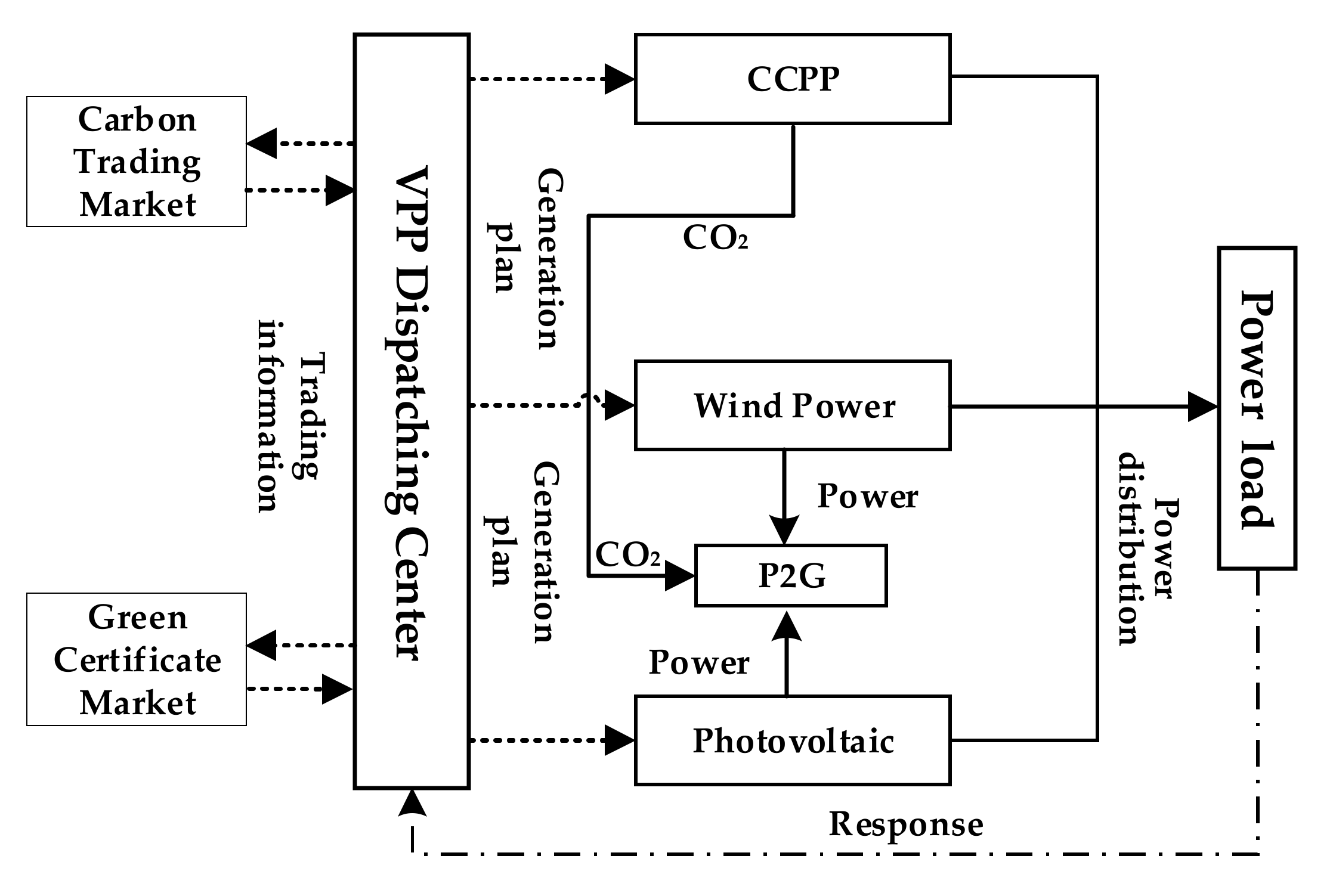
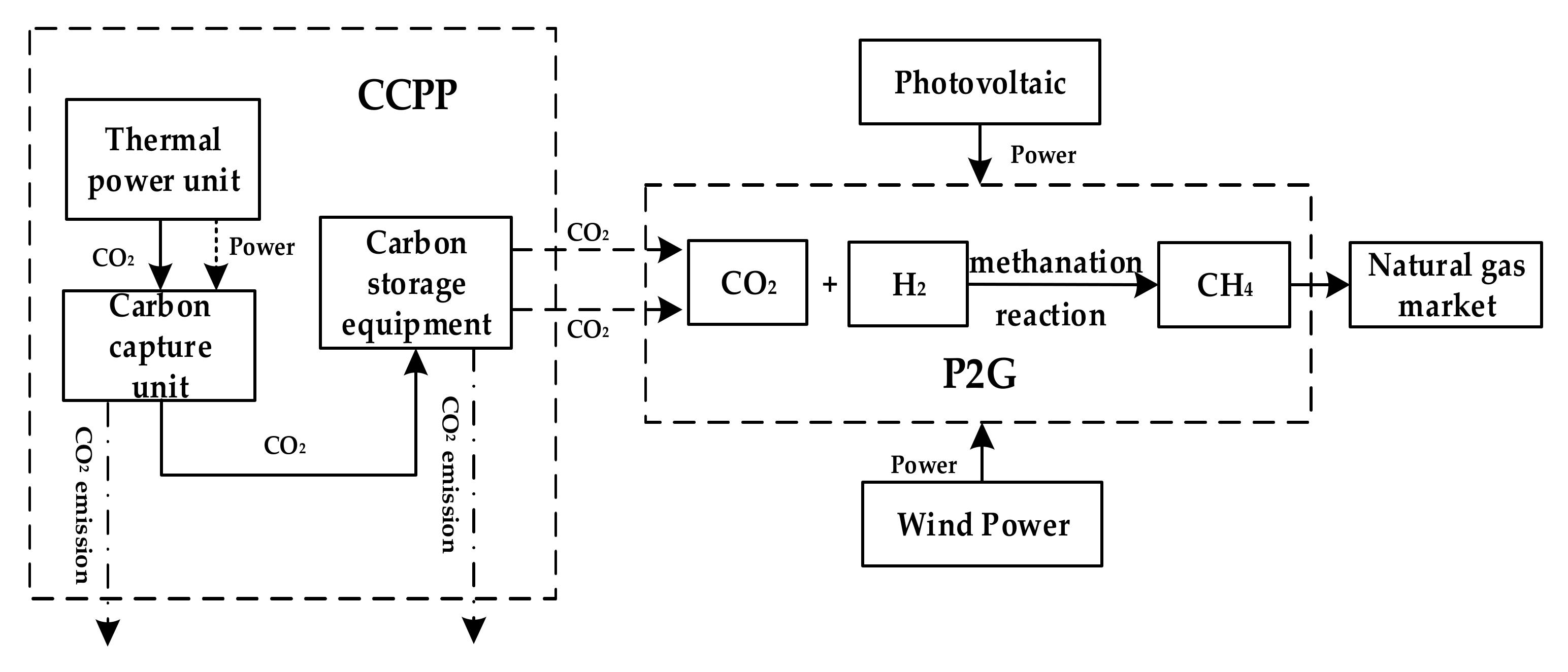
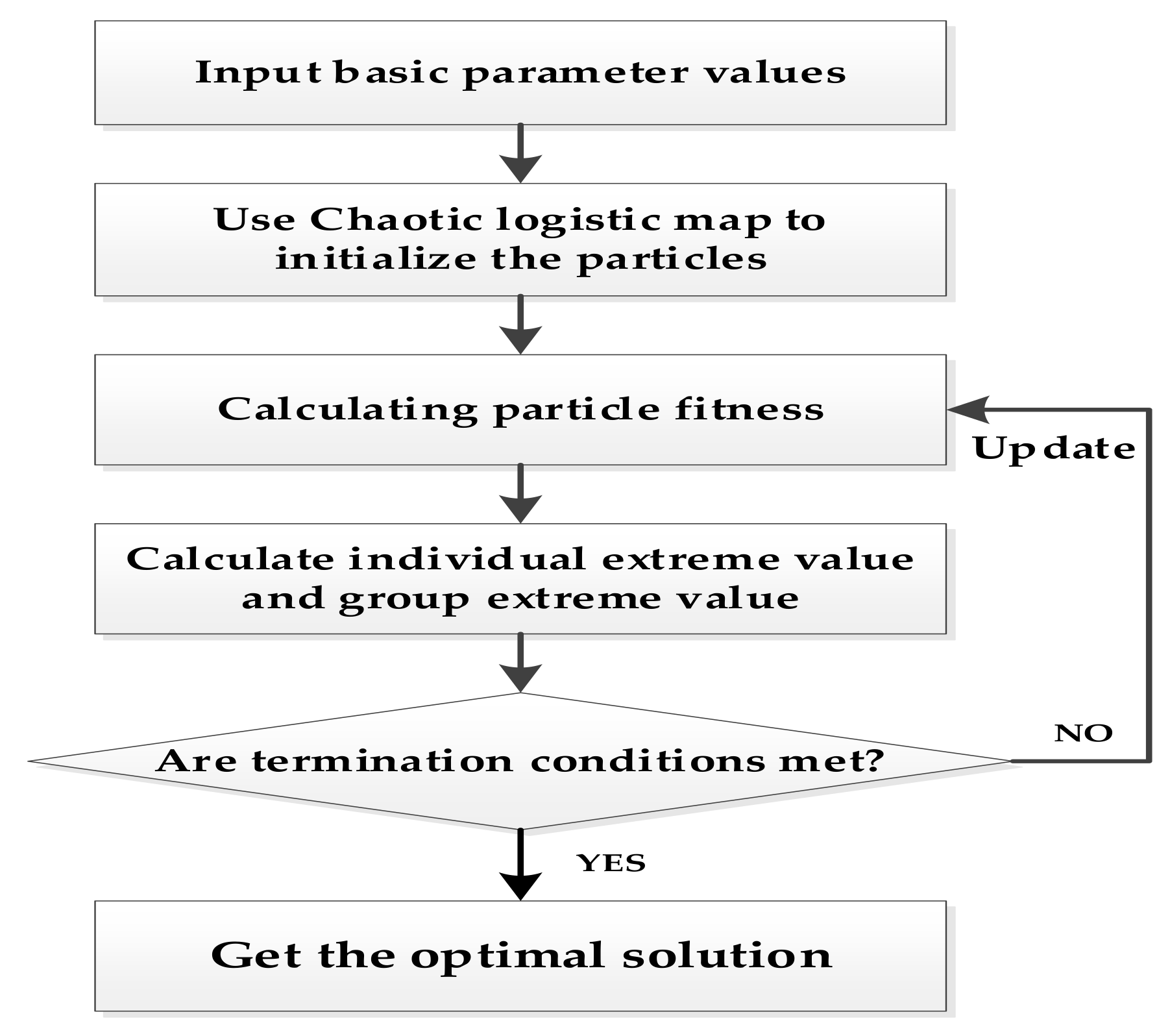
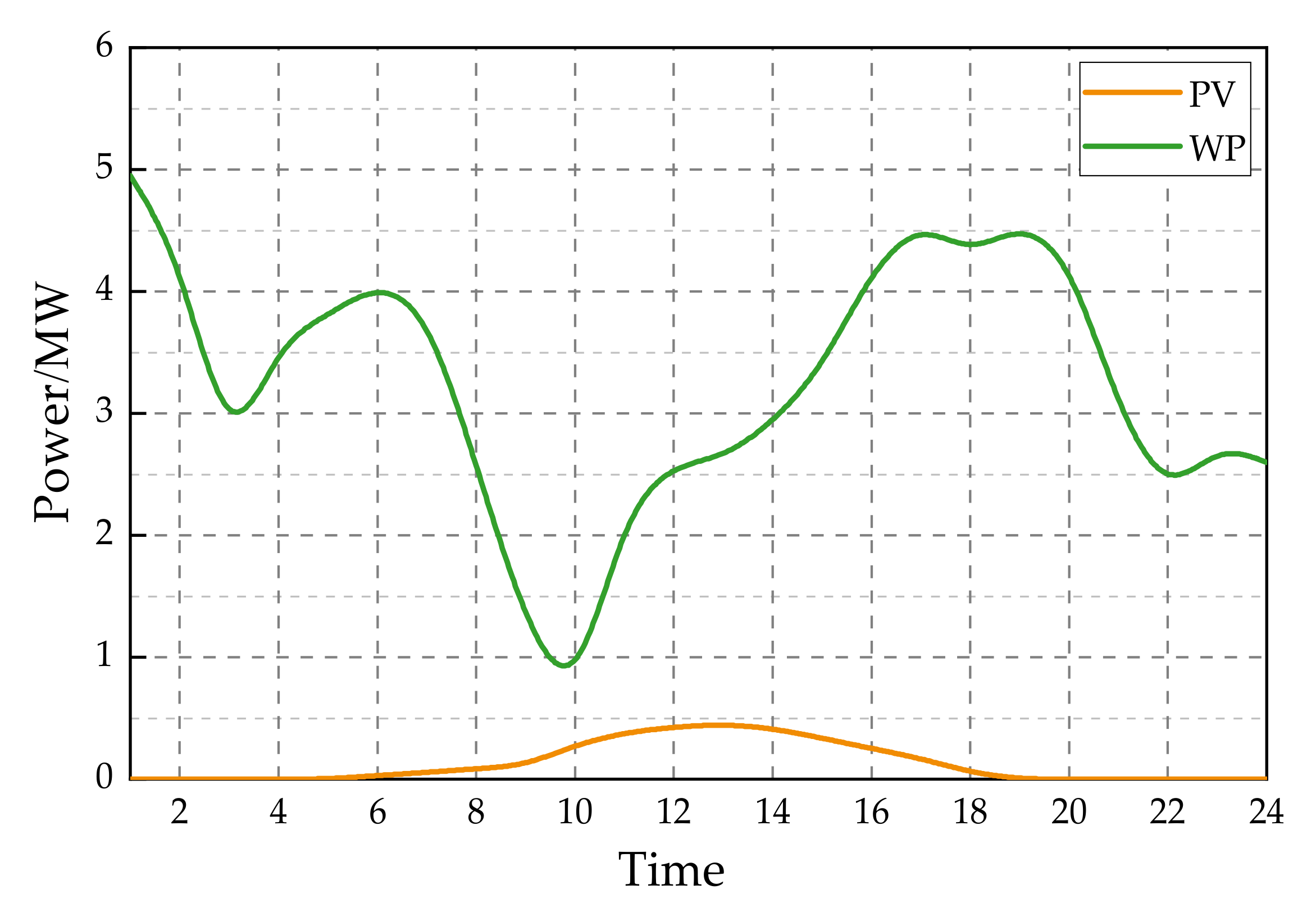

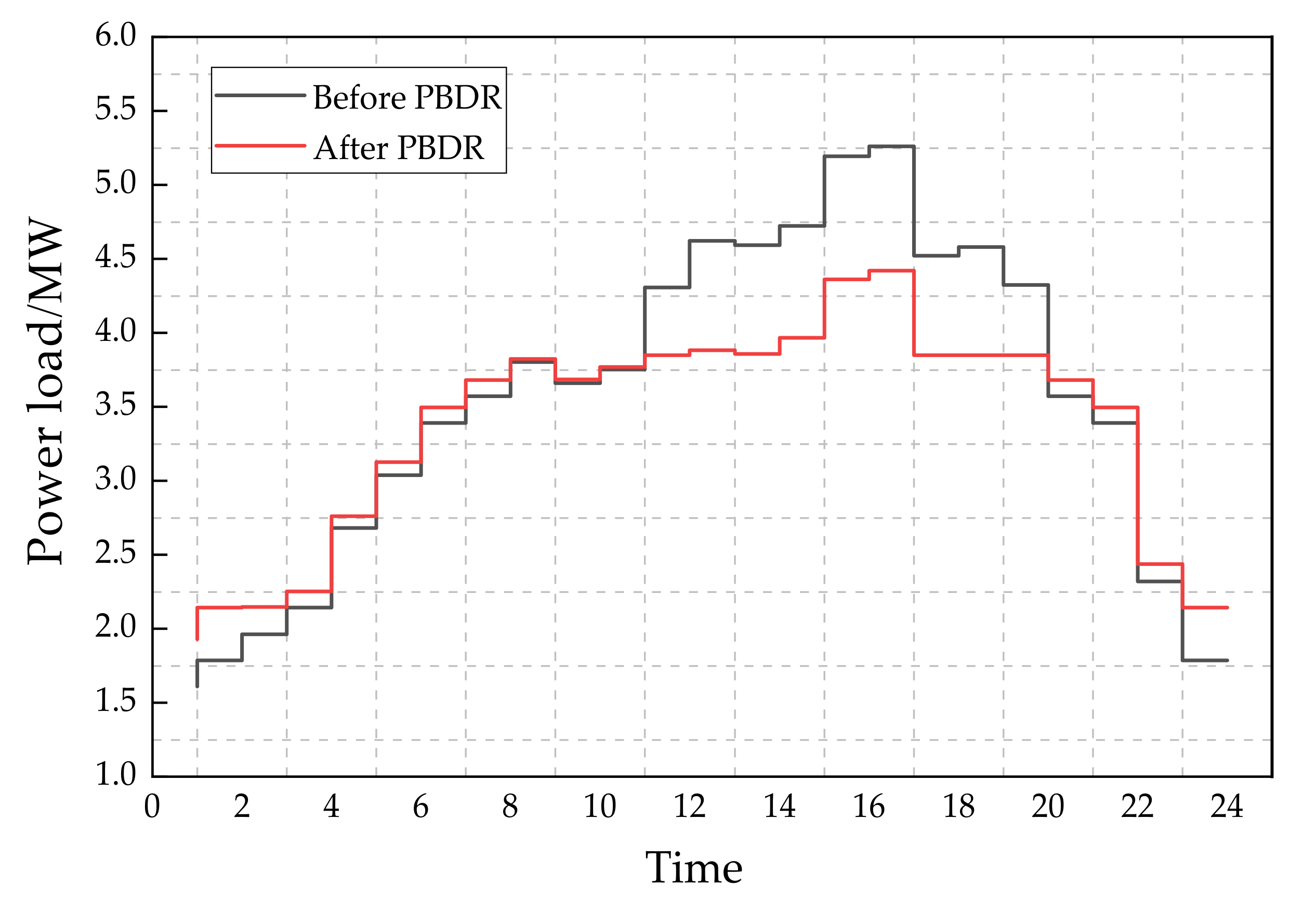
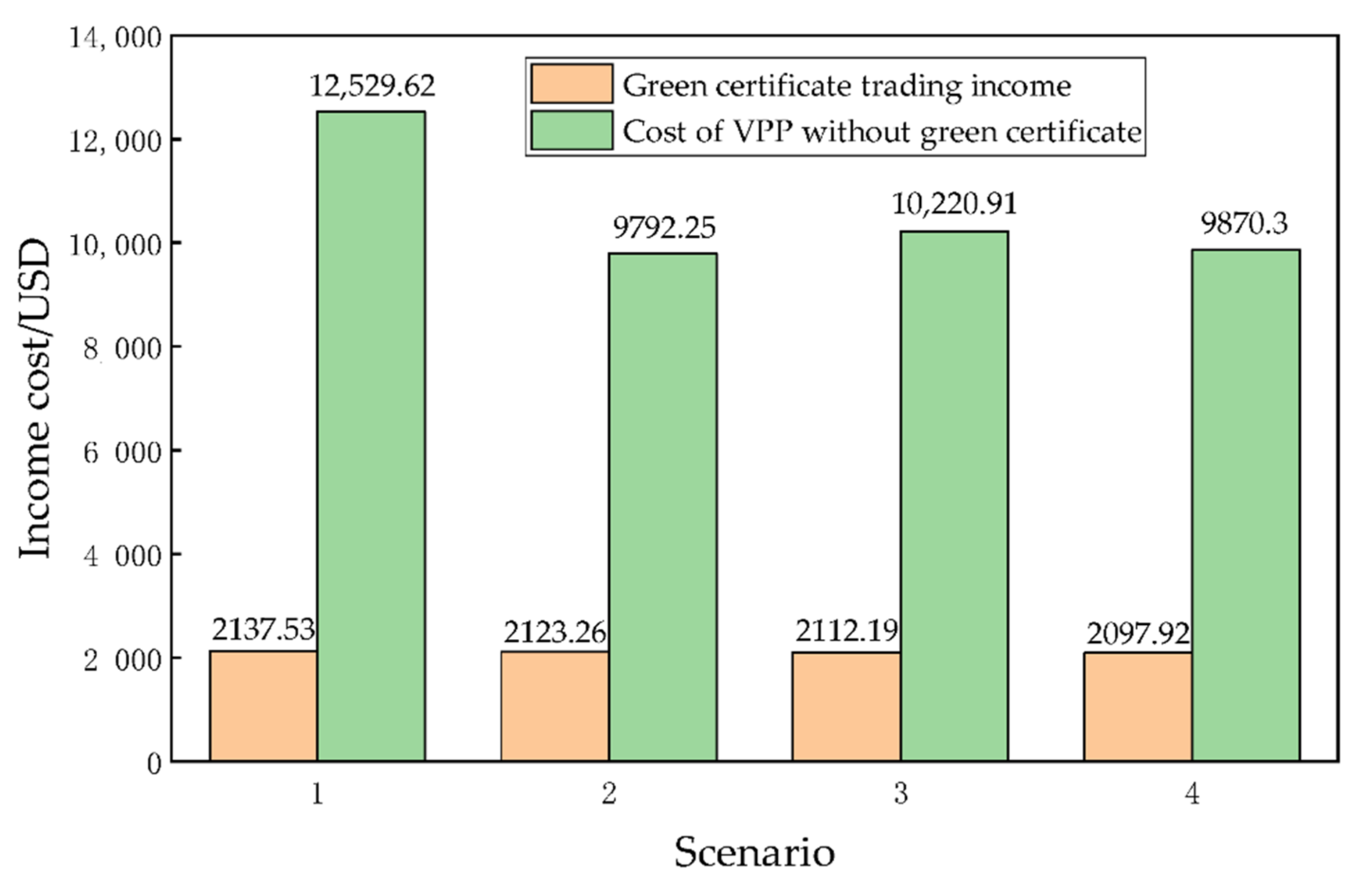
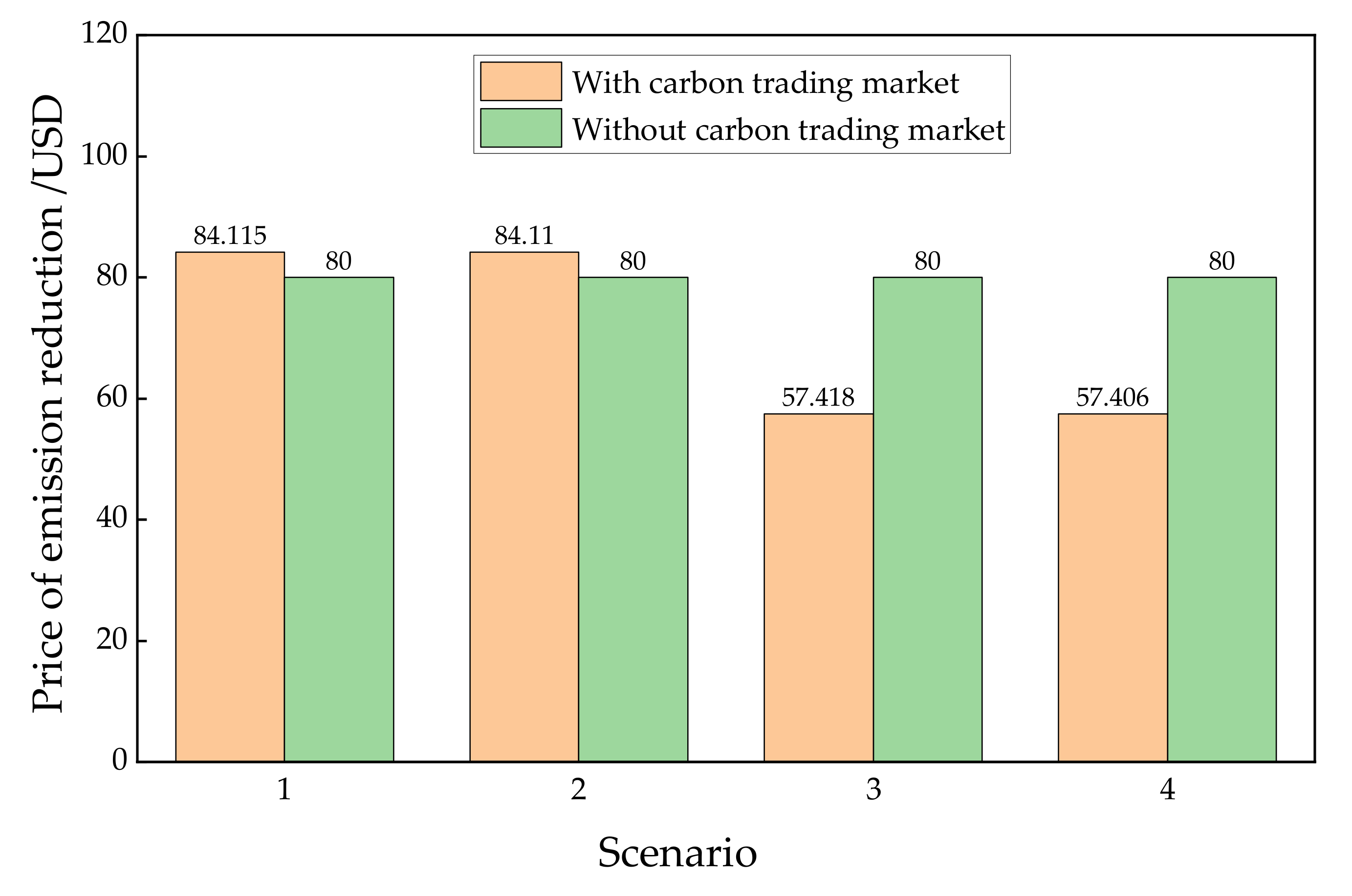
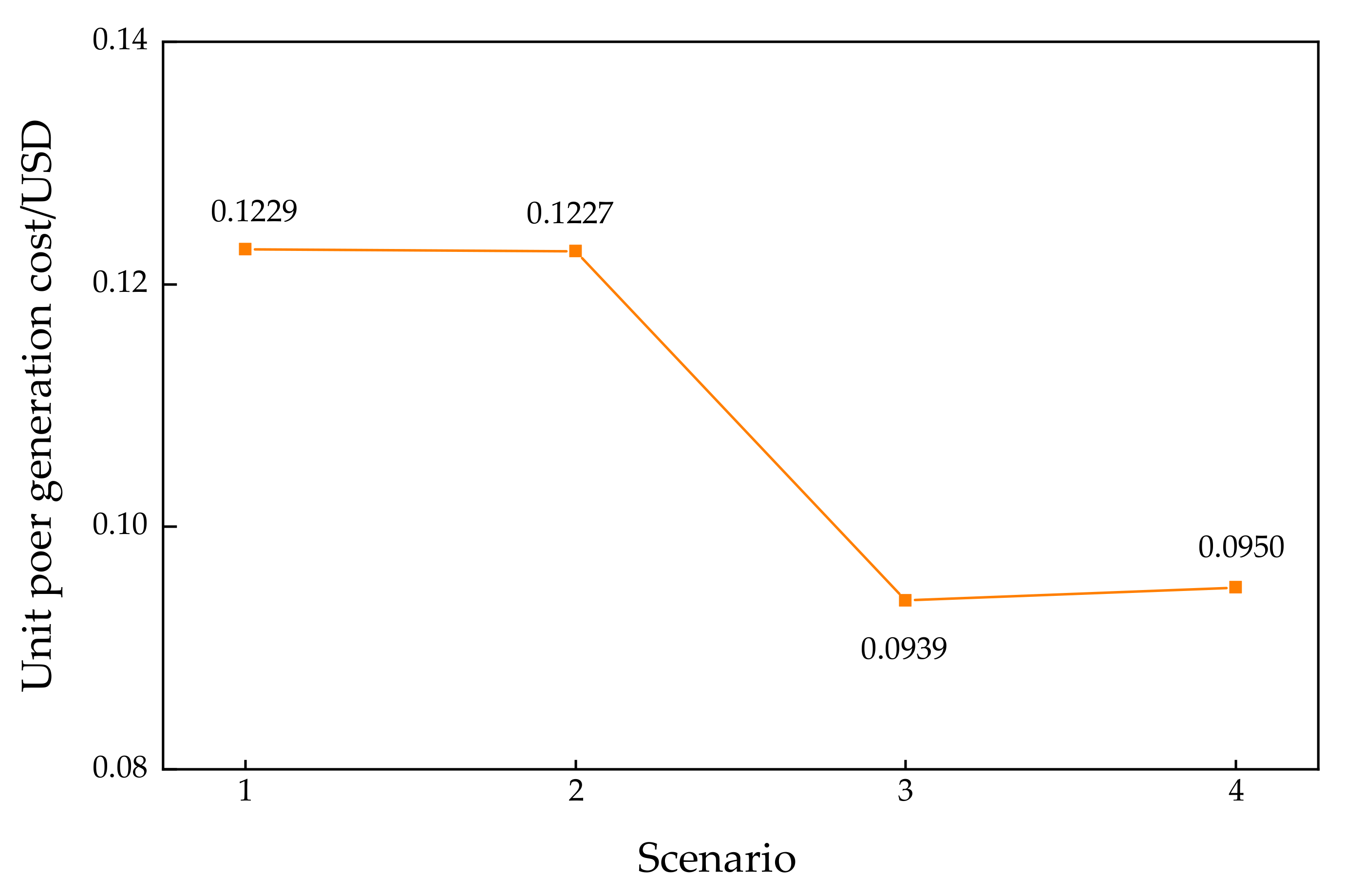

| Thermal Power Unit Parameters | P2G Parameters | ||||||||
|---|---|---|---|---|---|---|---|---|---|
| Minimum Output /MW | Maximum Output /MW | Cost Factors | Carbon Emission Intensity /(t/MW·h) | Maximum Operating Power /MW | Carbon Consumption /(t/MW·h) | Operating Cost /(USD/MW·h) | Conversion Efficiency | ||
| a | b | c | |||||||
| 0 | 10 | 0.01 | 5 | 50 | 0.96 | 3 | 0.2 | 20 | 0.6 |
| Carbon Capture Device Parameters | Carbon Storage Device Parameters | ||||||||
| Fixed energy consumption /MW | Carbon capture efficiency | The amount of CO2 captured per unit of energy consumption /(t/MW·h) | Loss factor | Minimum capacity /t | Maximum capacity /t | Carbon storage price /(USD/t) | |||
| 0.015 | 0.9 | 3.717 | 0.3 | 0 | 100 | 4.89 | |||
| Period of Electricity Price Change | Peak | Flat Section | Valley |
|---|---|---|---|
| peak | −0.18 | 0.06 | 0.1 |
| flat section | 0.06 | −0.18 | 0.08 |
| valley | 0.1 | 0.08 | −0.18 |
| Power Load Period | Electricity Price | Time Period |
|---|---|---|
| peak | /1.12 | 12:00–20:00 |
| flat section | /0.67 | 5:00–11:00/21:00–22:00 |
| valley | /0.33 | 23:00–4:00 |
| Cost Scenario | Carbon Tax | Generation Cost of CCPP | Carbon Trading | Carbon Storage | P2G | WP and PV | Green Certificate | Renewable Energy Curtailment | Total Cost |
|---|---|---|---|---|---|---|---|---|---|
| S1 | 1190.26 | 827.74 | 61.37 | 0.00 | 0.00 | 8720.07 | −2137.53 | 1730.18 | 10,392.09 |
| S2 | 858.25 | 606.06 | 44.25 | 0.00 | 0.00 | 8720.07 | −2123.26 | 1686.88 | 9792.25 |
| S3 | 604.62 | 856.86 | −170.54 | 62.93 | −36.91 | 8629.98 | −2112.19 | 107.27 | 7942.02 |
| S4 | 444.58 | 628.58 | −125.40 | 46.27 | −39.28 | 8629.98 | −2097.92 | 101.30 | 7588.11 |
| Scenario | Carbon Capture Equivalent Output/MW | Carbon Emission/t | Carbon Capture/t | Carbon Storage/t | P2G Power/MW | CO2 Consumed by P2G/t | Renewable Energy Curtailment/MW |
|---|---|---|---|---|---|---|---|
| S1 | 15.50 | 14.88 | 0.00 | 0.00 | 0.00 | 0.00 | 11.85 |
| S2 | 11.18 | 10.73 | 0.00 | 0.00 | 0.00 | 0.00 | 12.31 |
| S3 | 21.28 | 7.56 | 18.38 | 12.87 | 11.51 | 1.38 | 0.34 |
| S4 | 15.65 | 5.56 | 13.52 | 9.46 | 12.25 | 1.47 | 0.06 |
Publisher’s Note: MDPI stays neutral with regard to jurisdictional claims in published maps and institutional affiliations. |
© 2021 by the authors. Licensee MDPI, Basel, Switzerland. This article is an open access article distributed under the terms and conditions of the Creative Commons Attribution (CC BY) license (https://creativecommons.org/licenses/by/4.0/).
Share and Cite
Yan, Q.; Ai, X.; Li, J. Low-Carbon Economic Dispatch Based on a CCPP-P2G Virtual Power Plant Considering Carbon Trading and Green Certificates. Sustainability 2021, 13, 12423. https://doi.org/10.3390/su132212423
Yan Q, Ai X, Li J. Low-Carbon Economic Dispatch Based on a CCPP-P2G Virtual Power Plant Considering Carbon Trading and Green Certificates. Sustainability. 2021; 13(22):12423. https://doi.org/10.3390/su132212423
Chicago/Turabian StyleYan, Qingyou, Xingbei Ai, and Jinmeng Li. 2021. "Low-Carbon Economic Dispatch Based on a CCPP-P2G Virtual Power Plant Considering Carbon Trading and Green Certificates" Sustainability 13, no. 22: 12423. https://doi.org/10.3390/su132212423
APA StyleYan, Q., Ai, X., & Li, J. (2021). Low-Carbon Economic Dispatch Based on a CCPP-P2G Virtual Power Plant Considering Carbon Trading and Green Certificates. Sustainability, 13(22), 12423. https://doi.org/10.3390/su132212423





